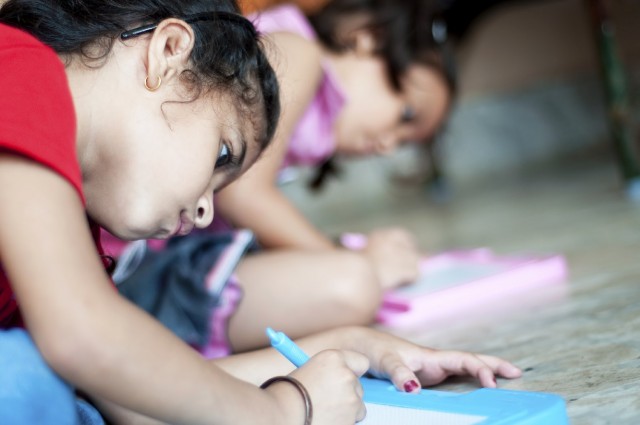
The following is an excerpt from Marsha Ratzel's new book In High Gear: My Shift Toward a Student-Driven, Inquiry Based Science Classroom.
Most classrooms follow a prescribed formula. Teachers plan and lay out what is going to be learned. Students come into class and have the responsibility of switching themselves into “ready” mode, waiting for the teacher to instruct and guide them in the day’s tasks. There is very little student ownership in this process.
Surely there were parts of the learning process where the control could be shifted to the students – where I could hand them responsibility and freedom and give them a voice in what they would learn. Although it would be impractical for me to think they could run a classroom as well as a veteran teacher, I hoped I could guide them as they took control of the questions they would pursue.
Knowing that handing students most of the responsibility for learning without preparation was not a realistic first step, I designed “skill-builders” to transition the classroom. I used layers of traditional teaching/learning experiences and experiences where the process was open-ended but had a clearly defined endpoint. This built skills in both my own teaching practice and in my students’ learning practice. I tested things for effectiveness and they developed the new personal skills to stay on course as their control of their own learning increased. Notably, experiencing small obstacles helped to develop students’ coping ability—an important skill for open-ended, open-process activities.
What would my classroom look like and how would it sound? So often, I thought, articles and blogs chatter about the idea of student empowerment but offer little in the way of practical strategies. I suspect the reason I failed to find these strategies for shifting the classroom is that the paths to perfecting this blend of student/teacher cooperation are so variable that it would be difficult to reduce it down to a “how to” explanation. Even now I struggle to describe it well.
After some searching and thinking, I determined that it was one of those things I would know when I saw it. For me, student empowerment looked like kiddos investing more time in their work and showing more energy for learning. I would see a new cycle of learning begin to develop. In my blog, I wrote about what this looked like outside of the classroom:
Why are students so busy learning things at home? They are huge into video games, basketball, clothing and so many other things. They are doing what Sheryl Nussbaum-Beach calls passion based learning. I've always wondered how a student can remember the umpteenth level of the most recent video game. They can map every twist and turn of how to get to the "nth" location and they will know everything they need to have in order to magically open the door. So why can't students remember their math facts? There's a huge gap between what I want them to learn and what they want to learn. Duh.
 Although I had an idea for where I wanted to take my students, I was disheartened because I didn’t know how to structure the class so they wanted to learn. Even while taking Sheryl’s online class and hearing all about passion-based learning, I felt dumb for not understanding how to implement “student empowerment.” Never before had I wanted to do something for my students and not been able to figure it out. I was stuck. Stuck because I couldn’t see how to meet the obligations of my job, teach the curriculum, and also provide students with this chance.
Although I had an idea for where I wanted to take my students, I was disheartened because I didn’t know how to structure the class so they wanted to learn. Even while taking Sheryl’s online class and hearing all about passion-based learning, I felt dumb for not understanding how to implement “student empowerment.” Never before had I wanted to do something for my students and not been able to figure it out. I was stuck. Stuck because I couldn’t see how to meet the obligations of my job, teach the curriculum, and also provide students with this chance.
Fortunately, Sheryl realized I was stumped and helped guide me to my “ah-ha” moment. She used an entire class period to show us how to plan for the transition. Here’s what I learned in that class meeting that changed things for me.
- First make sure to meet the school curriculum guides. Although that may take a bit of moving things around and not doing them as you’ve always done them before, it proved to be do-able. We listed out all the required curriculum topics, objectives and targets. Immediately I felt better knowing that what I was required to teach would get covered.
- Next we looked for places to condense teaching the required curriculum in order to make time at the end of the unit. This “extra” time really isn’t extra. It’s the time you recapture by not doing things that don’t really need to be done to learn the concepts. Maybe it’s repeated teachings that aren’t needed. You pare off small things that can give you a couple of “extra days” later in the unit.
- Then design the student-owned learning phase. Here students pick their topical study, keeping in mind what will be possible within those “extra days.”
- During the “extra days,” students have the freedom to pick the way in which they want to go about learning and/or the topic that interests them. In addition to the topical learning, students learn things that didn’t fit in before—such as managing their own time, researching their choices, or exploring questions that are tangentially related to the unit’s topic but excite interest.
Marsha Ratzel is a National Board-certified science and math teacher in the Blue Valley (KS) School District and a popular blogger (Reflections of a Techie).

